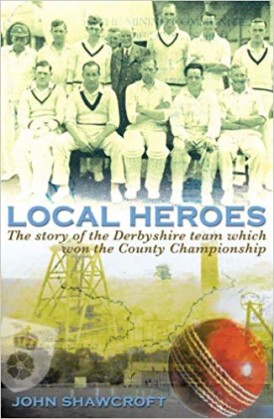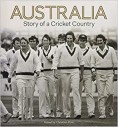Local Heroes: the story of the Derbyshire team which won the County Championship.
Jon Gemmell |Published: 2006
Pages: 205
Author: Shawcroft, John
Publisher: Sports Books
Rating: 4.5 stars

As a social historian by qualification, my primary interest in cricket’s vast literature is in how it allows for an understanding of the times in which the sport was played. John Shawcroft’s work centres on Derbyshire winning the 1936 County Championship – their greatest cricketing triumph – but is also an intriguing look at cricket and life between the war years.
Derbyshire have always been one of the smaller sides in English cricket’s top tier. From 1895-1919, they won 60 and lost 215 of 386 championship matches, a record that was the worst of any county. The 1920 season marked their nadir: they played 18, won none and lost 17, with one game abandoned. They exceeded 200 on only four occasions, used 39 players and picked a different team for every match.
A number of things came together to turn this underperforming side into champions. They invested in a cricketing nursery to develop young players. They also borrowed heavily from the leagues, while chosen professionals were all local players. Fundamental to the strengthening of the side was the role of the mining industry. Almost every town and most villages in North-east Derbyshire and parts of west Nottingham had its own pit, and most of these had a cricket team.
Shawcroft claims that Stan Worthington and Les Townsend formed the backbone of the champion Derbyshire side. Worthington was a key all-rounder, who often took the new ball. He scored a career total of 19,221 runs, with 31 centuries and also took 682 wickets. Townsend was described by Herbert Sutcliffe as a spot bowler, one who consistently pitched the ball on a chosen spot. To these must be added fast-bowler Bill Copson, opener Dennis Smith, the Pope brothers and leg-spinner Tommy Mitchell, who initially turned down an offer to play for the county because he could earn more working down the mines.
Each of the above players had worked in the mining industry, with the exception of Townsend who was initially employed in the lace trade. Many played in the Bassetlaw and District League, founded in 1903, that brought clubs from Derby, Nottingham, South Yorkshire and Lincolnshire together. During the 21 interwar years the league was won by a colliery club for all but one season. A key match against Notts in the 1936 season was played at the league ground at Worksop. Sixteen players with Bassetlaw associations took part in the contest.
A spirit of togetherness owed much to their backgrounds. Smith said of Copson that he would always keep going. ‘I think this was partly because he had worked down the pits and knew what hard work was. I’ve seen him with 12 yards of bandage holding him together and, even then, he made the batsmen play at every ball.’ It must have also helped that all the professionals were local players. Indeed, when Derbyshire played Lancashire in 1936, they fielded an all-county born team – the last occasion they did.
Reading about the past allows us to see how much the sport has changed. Harry Storer and Charlie Elliott, for example, reported late for the season’s start because of their commitments with Coventry City. Storer had to miss an important match against Gloucestershire as he was needed at Highfield Road. Tobacco firms were noticing the side’s success by featuring some of their players on cigarette cards. In their championship winning season, Derbyshire played their home matches on five different grounds.
Shawcroft writes with affection for the players, but also with a respect for the wider context in which the sport was played. The day Derbyshire were crowned champions, for example, Madrid suffered its first air raid of the Spanish Civil War. A mining disaster at the Markham pit on 10 May 1938 resulted in the loss of life of 79 people with 38 injured. A few days afterwards Derby beat Surrey at Queens Park in a match said to be watched by widows who went because their husbands would have been there. On the final day of the 1939 season, lost to rain, Germany invaded Poland; two days later, Britain was at war.
Seven of the championship-winning side played for England during their careers, but none became established. This was a team with no real stars but players capable of performing at the highest level. Nine played in 26 or more matches out of 28 in the 1936 season; eight of these came from the club’s nursery. Wisden included Copson and Worthington in its five Cricketers of the Year.
Many returned to the mines on retirement. Mitchell once said: ‘I was as good a workman down the pit as I was on the cricket field’, adding: ‘It was just a case of pulling together – and everybody did.’ Shawcroft concludes his work: ‘It is a fitting epitaph for that considerable team.’ Those words provide a fitting ending for a work that deserves a wider audience, both cricket fans and historians.






Leave a comment